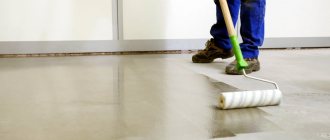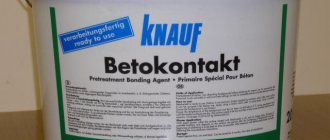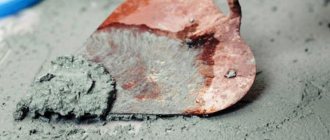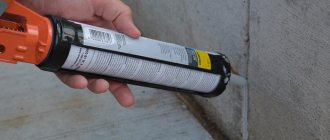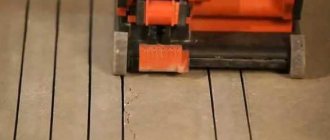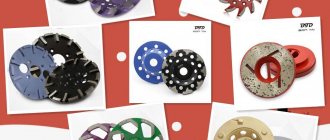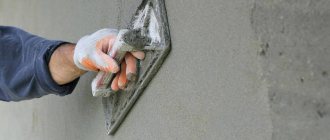Despite its strength, concrete is susceptible to the influence of humidity and temperature, mold, mildew and other microorganisms form on it. All this leads to the destruction of structures, which over time begin to look unsightly. Special concrete paint for exterior use (wear-resistant, moisture-resistant and durable) will allow you to preserve the facade of the building, the fence and the flooring inside the house for a long time not only from mechanical damage, but also from other negative “phenomena”.
To determine what to paint concrete on the street with, first of all we will consider the properties that such compositions should have.
Painting concrete surfaces - what are the features?
Untreated concrete base is hardened cement, porous and coarse-grained. This texture quickly begins to crumble and become dusty even with minimal impact; when moisture gets in, the concrete breaks down even faster. Water washes out some components of the composition, and at low temperatures freezes in the pores, reducing the strength of the material.
To eliminate these problems, strengthening substances are introduced into the cement mixture, and then additionally stabilized using painting, which eliminates dust, smoothes out roughness, fills the loose structure and protects from moisture, and forms a resistant film that prevents the material from crumbling.
Concrete walls, ceilings, floors, foundations and sidewalks can be painted.
Note! It’s good if the enamel has good hiding power and one layer is enough to completely change the original color of the concrete.
Tools and materials
Working equipment for the classic painting procedure:
- roller or spray bottle;
- paint brushes, scrapers, sanding material;
- bath for dye.
The high-quality painting procedure requires the use of the following products:
- dye selected for the intended use;
- high-quality degreaser for concrete surfaces;
- primer to improve adhesion;
- sealant.
If the process of painting concrete is carried out near flower beds or a garden, you need to purchase plastic film to cover the green area. This manipulation will protect the vegetation from contact with the chemicals used.
Types of concrete paints that are suitable for interior and exterior work
Concrete paint is selected based on several criteria. The most important is where the work is carried out - outside or inside the premises. For outdoor work, it is important that the material is resistant to low temperatures and UV rays, moisture resistant, dries quickly and looks aesthetically pleasing.
Indoor paint must be safe for health and not contain highly toxic components. For both indoor and outdoor work, the paint should protect the concrete from moisture.
Basic requirements for paint, regardless of where it is used:
- good adhesion,
- vapor permeability,
- abrasion resistance,
- economical consumption.
Classification by composition and type of surface to be painted
To get the desired result, experts recommend paying great attention to choosing the right paint for concrete. There is a lot of different information on the Internet, but there is a standard gradation of materials according to composition and type of surface to be painted.
You can list the main materials by composition:
- Acrylic. These paints are popular not only for concrete surfaces. They contain special polymers and their derivatives, under the influence of which a dense, elastic, breathable film is obtained. Among the advantages of acrylic paints, it is worth noting wear resistance, economical consumption, low price, good hiding power, ease of application, durability of the coating, high drying speed and the ability to use in moderately damp rooms.
- Among the disadvantages, they note the need for careful preparation of the surface for painting, including preliminary priming.
- It is important not to confuse acrylic and alkyd enamels. Alkyd paints are oil paints. They form a hard film on the surface, whose performance properties are worse than those of acrylic compounds.
- Epoxy. They contain epoxy resin and hardener, which must be mixed with a construction mixer to obtain finished enamel. The result is that a waterproof, durable film hardens on the concrete base, which is resistant to any type of impact and retains its appearance for a long time. Therefore, it is often purchased for painting concrete floors. Depending on additional components, the film can be flexible or rigid.
- Among the disadvantages is the possibility of an error in proportions during preparation of the composition.
- Vinyl. These paints create a beautiful matte surface, dry quickly, cover well in one coat, are odorless, environmentally friendly and hypoallergenic. However, now they have almost been replaced by acrylic analogues, since the service life of vinyl coating is no more than 7 years, it is not moisture resistant enough and almost does not “breathe”, which means that concrete deteriorates faster.
- Polyurethane. This is an ideal paint for concrete floors. Particularly resistant to abrasion and mechanical stress. The only negative is the long drying time; complete drying takes up to two weeks.
- Rubber. The consistency is similar to mastic, which after drying resembles rubber. The coating is very durable, but at the same time elastic due to the acrylate latex in the composition. One of the advantages is frost resistance: you can work with paint outside even at -50 degrees. Latex paints are often used on playgrounds and sports fields.
- Water-based. The main component of paint is water, so such materials are non-toxic, easy to wash off, do not smell and are available in a wide palette of shades.
- Silicone emulsion. One of the best offers in terms of its characteristics on the market. It can be used within two days after the concrete has hardened. The enamel forms a completely waterproof, but at the same time “breathable” coating, has high adhesion, is elastic, and wear-resistant. The only drawback is the very high price.
Depending on the surface that is supposed to be painted, there are:
- Concrete enamel for facade. Concrete walls of buildings must be protected from aggressive environmental influences. What is important here is the high penetrating ability of the composition and economical consumption, as well as service life, since repainting building facades is not a very fast and labor-intensive process.
- Foundation paints. Acrylic, polyurethane, epoxy, and silicone compounds are suitable here. When choosing, you need to be guided by the characteristics of concrete and environmental factors. For example, for cold regions, paints based on epoxy resins are used.
- Floor paints. Paints for concrete floors must meet several criteria - resistance to abrasion and mechanical damage, as well as moisture resistance. Polyurethane, acrylic, rubber, epoxy enamels have these properties.
- Materials for painting paving slabs, concrete garden paths and blind areas. The same requirements apply to these paints as to floor paints. But additional attention is paid to protection from precipitation, so acrylic compounds are not suitable here.
Epoxy compounds
The material consists of two components. It is produced on a water basis and is diluted before use in accordance with the appropriate proportions. Afterwards it is mixed well using a mixer and applied to the available surface.
The material forms a protective film and looks great. Among the advantages, I would like to highlight several factors.
- High safety characteristics. This paint is chosen for work in kindergartens, clinics, hospitals, etc.
- Water resistance. Thanks to this property, it is possible to decorate, among other things, rooms with high humidity levels. And this is an important factor for swimming pools, baths and other similar objects.
- Resistance to chemical reagents. Epoxy is chosen for workshops and laboratories, as well as parking lots.
- There are no strong odors, which means there is no need for long-term ventilation immediately after painting.
- The epoxy layer does not turn yellow when exposed to sunlight, retaining its original color for a long time, and is easy to clean using any product.
The presence of the coating will shorten the period of construction work, since paint can be applied to “fresh” concrete within 5 days after it is poured. This avoids the accumulation of dirt, increases adhesion, and strengthens the material.
In addition, the coating looks great; thanks to its presence, you can create both a certain relief and a perfectly smooth, glossy version. At the same time, defects and unevenness of the walls are cleverly masked.
How to choose the right paint
To choose a good paint, it is recommended to pay attention to several points.
First you need to assess the intensity of use of the concrete base. For example, to paint walls you will need less wear-resistant enamel than to paint a concrete floor in a garage.
It is important where the painting will be done. For interior work, non-toxic, odorless enamel is required. For outdoor work, resistance to precipitation, UV rays and external damage is important.
Many manufacturers produce universal paints, and before choosing one, you need to carefully study the composition information on the label and recommendations for use.
There is a complete list of requirements for enamels for concrete, however, there is still not a single brand that could combine them all:
- waterproofing properties;
- resistance to low and high temperatures;
- fire resistance;
- health safety;
- neutral smell;
- resistance to physical and mechanical damage;
- ease of care.
Additional Information
Drying time and consumption are characteristics, the determination of which helps to optimize the time spent on work. Manufacturers usually write on the label how long it takes for the layer to dry completely. After this, they usually proceed immediately to the next coating. Concrete paint dries on average within 2-5 hours. But the concrete becomes completely ready in at least a day.
120-400 ml of the composition is required to cover a square meter of surface with one full layer of paint. Specific characteristics depend on the type of paint used.
Painting concrete outside involves a preparatory stage - cleaning the working surface. There should be no grease and oil stains on the concrete, as well as dirt, dust, and lime. The old paintwork is also completely removed, otherwise weather-resistant coatings will not be created.
When it comes to external facades, a strong stream of ordinary water can be used to wash away dirt. In other cases, the impact should be more severe.
A grinder and a drill, a brush and metal brushes also become indispensable assistants when cleaning the surface. For brushes, it is important to use the shortest possible bristles. Paint chips will clog the lint if the work surface gets too hot.
How else can you paint concrete (2 videos)
Products of different brands (24 photos)
Which wear-resistant material should I use for a concrete floor to avoid dust?
When deciding what to paint a concrete floor with, craftsmen recommend paying attention to deep penetration paints. The porous structure of concrete is very fragile and when the partitions between the pores break, the surface begins to gather dust. To avoid this, you need to fill the empty pores with paint, which will give strength to the material and increase its wear resistance.
There are two methods of painting concrete - deep and surface.
With deep coloring, the enamel penetrates deep into the porous structure of concrete, giving it a lasting color and improving the strength and durability of the material. This technology is quite expensive, so surface painting is often used.
Epoxy, polyurethane or rubber are commonly used as wear-resistant paints for concrete floors. Polyurethane can be painted in industrial premises due to its high resistance to mechanical damage.
Note! In order for the paint to adhere well, you must first prime the concrete screed. The use of deep penetration primer and paint will ensure optimal durability of the coating.
Preparing concrete walls for painting
The process of preparing concrete walls for painting consists of several stages.
- Surface cleaning, which may include: removal of old oil paint, removal of mold and dirt. If the concrete is fresh, cement laitance forms on its surface, which must be sanded after the material has dried.
- Removing dust from the surface (you can use a vacuum cleaner).
- If there are cracks and potholes, they are filled with plaster, putty or polyurethane foam.
- After the mixture has dried, the surface is sanded manually or with a special grinding machine and then primed.
Now you can proceed to painting, having previously carried out tinting. To do this, use a white base paint and add pigment.
Polyurethane enamel
The dye has all the necessary characteristics - it is resistant to most types of negative influences, is not afraid of chemicals, precipitation, and temperature changes.
But the main advantage is the spectacular look that paint can give to concrete surfaces. Among the interesting options is luminous enamel, which makes even the most inconspicuous concrete wall unique.

